词汇学术语
自考英语词汇学学术语单词对照表
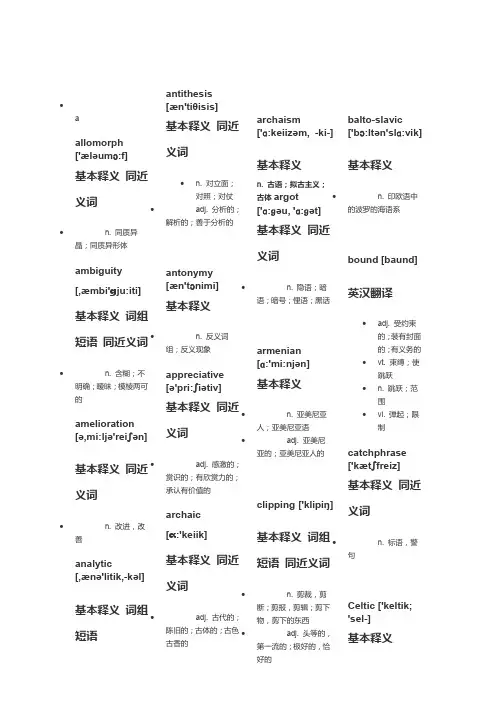
∙aallomorph['æləumɔ:f]基本释义同近义词∙n. 同质异晶;同质异形体ambiguity[,æmbi'ɡju:iti]基本释义词组短语同近义词∙n. 含糊;不明确;暧昧;模棱两可的amelioration[ə,mi:ljə'reiʃən]基本释义同近义词∙n. 改进,改善analytic[,ænə'litik,-kəl]基本释义词组短语antithesis[æn'tiθisis]基本释义同近义词∙n. 对立面;对照;对仗∙adj. 分析的;解析的;善于分析的antonymy[æn'tɔnimi]基本释义∙n. 反义词组;反义现象appreciative[ə'pri:ʃiətiv]基本释义同近义词∙adj. 感激的;赏识的;有欣赏力的;承认有价值的archaic[ɑ:'keiik]基本释义同近义词∙adj. 古代的;陈旧的;古体的;古色古香的archaism['ɑ:keiizəm, -ki-]基本释义n. 古语;拟古主义;古体argot['ɑ:ɡəu, 'ɑ:ɡət]基本释义同近义词∙n. 隐语;暗语;暗号;俚语;黑话armenian[ɑ:'mi:njən]基本释义∙n. 亚美尼亚人;亚美尼亚语∙adj. 亚美尼亚的;亚美尼亚人的clipping ['klipiŋ]基本释义词组短语同近义词∙n. 剪裁,剪断;剪报,剪辑;剪下物,剪下的东西∙adj. 头等的,第一流的;极好的,恰好的balto-slavic['bɔ:ltən'slɑ:vik]基本释义∙n. 印欧语中的波罗的海语系bound [baund]英汉翻译∙adj. 受约束的;装有封面的;有义务的∙vt. 束缚;使跳跃∙n. 跳跃;范围∙vi. 弹起;限制catchphrase['kætʃfreiz]基本释义同近义词∙n. 标语,警句Celtic ['keltik;'sel-]基本释义∙adj. 凯尔特人的;凯尔特语的∙n. 凯尔特语(等于Keltic)collocation[,kɔləu'keiʃən]英汉翻译∙n. 搭配;配置;排列colloquialism[kə'ləukwiəlizəm]基本释义同近义词∙n. 白话,口语;口语体;方言用语concatenation[kɔn,kæti'neiʃən]基本释义同近义词∙n. 串联,连结connotation[,kɔnəu'teiʃən]基本释义同近义词∙n. 内涵;含蓄;暗示,隐含意义;储蓄的东西(词、语等)constituent[kən'stitjuənt]基本释义词组短语同近义词∙n. 成分;选民;委托人∙adj. 构成的;选举的consultative[kən'sʌltətiv]基本释义词组短语同近义词∙adj. 咨询的couplet ['kʌplit]基本释义同近义词∙n. 对联;对句degradation[,deɡrə'deiʃən]基本释义词组短语同近义词∙n. 退化;降格,降级;堕落deletion[di'li:ʃən]基本释义词组短语同近义词∙n. 删除;[遗]缺失;删除部分denizen['denizən]基本释义同近义词∙vt. 给…居住权;移植∙n. 居民;外来语;外籍居民denominal[di'nɔminəl]基本释义∙adj. 来自名词(形容词)的∙n. 来自名词(形容词)的词denotation[,di:nəu'teiʃən]基本释义同近义词∙n. 符号;表示;意义;指示derivation[,deri'veiʃən]∙基本释义词组短语同近义词n. 引出;来历;词源derogatory[di'rɔɡətəri]基本释义词组短语同近义词adj. 贬损的diachronic[,daiə'krɔnik,-kəl]基本释义∙adj. 探求现象变化的;历经时间长河duplication[,dju:pli'keiʃən]英汉翻译∙n. 复制;副本;成倍equivalent[i'kwivələnt]英汉翻译∙adj. 等价的,相等的;同意义的∙n. 等价物,相等物etymology[,eti'mɔlədʒi]基本释义∙n. 语源,[语] 语源学[ 复数etymologies ]euphemism['ju:fimizəm]基本释义同近义词∙n. 委婉语;委婉说法morpheme['mɔ:fi:m]基本释义∙n. [语] 词素;形态素generalisation[,dʒenərəlai'zeiʃən, -li'z-]基本释义同近义词∙n. (英)一般化;归纳;普遍原理(等于generalization)grammatical[ɡrə'mætikəl]基本释义词组短语同近义词∙adj. 文法的;符合语法规则的graphology[ɡræ'fɔlədʒi]基本释义∙n. 笔迹学;笔迹相法;图表法hellenic[he'lenik, -'li:-]基本释义同近义词∙adj. 希腊的;希腊人的;希腊语的heterogeneous[,hetərəu'dʒi:njəs]基本释义词组短语同近义词∙adj. [化学]多相的;异种的;[化学] 不均匀的;由不同成分形成的homograph['hɔməuɡrɑ:f, -ɡræf]基本释义∙n. 同形异义字homonym['hɔməunim]基本释义∙n. 同音异义词;同形异义词;同形同音异义词;同名异物homonymy[hɔ'mɔnimi]基本释义∙n. 同音异义homophone['hɔməufəun]基本释义∙n. 同音异形异义字idiom ['idiəm]基本释义同近义词∙n. 成语,习语;土话idiomatic[,idiə'mætik]基本释义词组短语∙adj. 惯用的;符合语言习惯的;通顺的Iranian[i'reinjən]基本释义∙adj. 伊朗的;伊朗人的;伊朗语的∙n. 伊朗人;伊朗语initialism[i'niʃəlizəm]基本释义同近义词∙n. 首字母缩略词intimate['intimət]基本释义词组短语同近义词∙adj. 亲密的;私人的;精通的;有性关系的∙n. 知己;至交∙vt. 暗示;通知;宣布juxtaposition[,dʒʌkstəpə'ziʃən]基本释义同近义词∙n. 并置,并列;毗邻lexical['leksikəl]基本释义词组短语同近义词∙adj. 词汇的;[语] 词典的;词典编纂的lexicography[,leksi'kɔɡrəfi]基本释义∙n. 词典编纂lexicology[,leksi'kɔlədʒi]基本释义∙n. 词汇学;词典学lexis ['leksis]基本释义同近义词∙n. 词汇;词语literary ['litərəri]基本释义词组短语同近义词∙adj. 文学的;书面的;精通文学的loan [ləun]基本释义词组短语同近义词∙n. 贷款;借款∙vi. 借出∙vt. 借;借给metaphor['metəfə]基本释义同近义词∙n. 暗喻,隐喻;比喻说法metonymy[mi'tɔnimi, mə-]基本释义∙n. 转喻monolingual[,mɔnəu'liŋɡwəl]基本释义∙adj. 单语的;仅用一种语言的;仅懂一种语言的∙n. 只用一种语言的人monosomic[,mɔnəu'səumik]基本释义同近义词∙adj. 单(染色)体的morphology[mɔ:'fɔlədʒi]基本释义词组短语同近义词∙n. 形态学,形态论;[语] 词法,[语]词态学neoclassical[,ni:əu'klæsikəl]基本释义词组短语∙adj. 新古典主义的neologism[ni:'ɔlədʒizəm,ni-]基本释义同近义词∙n. 新词;新义;新词的使用notional['nəuʃənəl]基本释义同近义词∙adj. 概念性的;想像的;抽象的;不切实际的obsolete['ɔbsəli:t, ,ɔbsə'li:t]基本释义词组短语同近义词∙adj. 废弃的;老式的∙n. 废词;陈腐的人vt. 淘汰;废弃onomatopoeic[,ɔnə,mætə'pi:k]英汉翻译∙adj. 拟声的;声喻的orthographic[,ɔ:θəu'ɡræfik]基本释义词组短语同近义词∙adj. 正字法的;拼字正确的;直角的pejoration[,pi:dʒə'reiʃən]基本释义同近义词∙n. 恶化;堕落;语义的转贬polysemic网络释义多义性polysemous[,pɔli'si:məs]基本释义∙adj. 一词多义的;有多种解释的reduplication[ri,dju:pli'keiʃən]基本释义同近义词∙n. 加倍;复本;复制器;重复referential[,refə'renʃəl]基本释义词组短语同近义词∙adj. 指示的;用作参考的Scandinavian[,skændi'neiviən; -vjən]基本释义∙n. 斯堪的纳维亚人;斯堪的纳维亚语;北欧日耳曼语系∙adj. 斯堪的纳维亚的;斯堪的纳维亚人的;斯堪的纳维亚语的;北欧日耳曼语系的semantic[si'mæntik]基本释义词组短语∙adj. 语义的;语义学的(等于semanticalsubordinate[sə'bɔ:dinət,-neit,sə'bɔ:dineit]基本释义词组短语同近义词∙n. 下属,下级;部属,属下∙adj. 从属的;次要的∙vt. 使……居下位;使……服从[ 过去式subordinated过去分词subordinated 现在分词subordinatingsuperordinate[,sju:pə'rɔ:dinət]基本释义同近义词∙adj. 上级的,地位高的;高级的[ 过去式superordinated 过去分词superordinated现在分词superordinating ]synthetic[sin'θetik]基本释义词组短语同近义词∙adj. 综合的;合成的,人造的∙n. 合成物triplet ['triplit]基本释义词组短语同近义词∙n. 三个一组;三连音符;三元组中的一个;三胞胎之一verbal ['və:bəl]基本释义词组短语同近义词∙adj. 口头的;言语的;动词的;照字面的∙n. 动词的非谓语形式unabridged[,ʌnə'bridʒd]基本释义同近义词∙adj. 完整的;未经删节的;足本的。
英语词汇学术语表
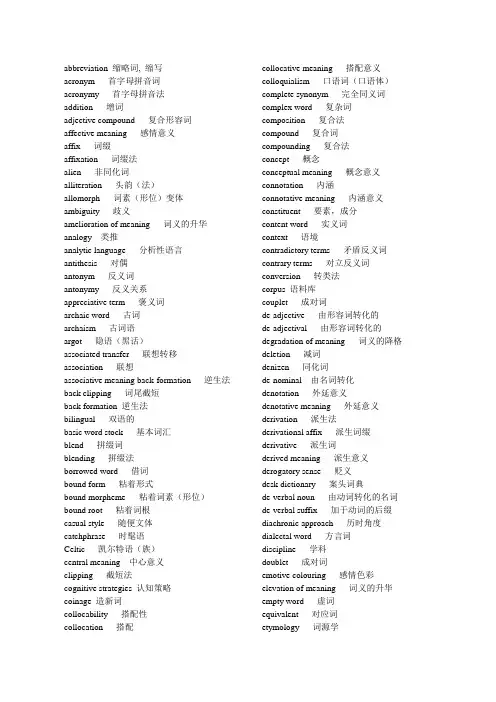
abbreviation 缩略词, 缩写acronym 首字母拼音词acronymy 首字母拼音法addition 增词adjective compound 复合形容词affective meaning 感情意义affix 词缀affixation 词缀法alien 非同化词alliteration 头韵(法)allomorph 词素(形位)变体ambiguity 歧义amelioration of meaning 词义的升华analogy类推analytic language 分析性语言antithesis 对偶antonym 反义词antonymy 反义关系appreciative term 褒义词archaic word 古词archaism 古词语argot 隐语(黑话)associated transfer 联想转移association 联想associative meaning back-formation 逆生法back clipping 词尾截短back formation 逆生法bilingual 双语的basic word stock 基本词汇blend 拼缀词blending 拼缀法borrowed word 借词bound form 粘着形式bound morpheme 粘着词素(形位)bound root 粘着词根casual style 随便文体catchphrase 时髦语Celtic 凯尔特语(族)central meaning中心意义clipping 截短法cognitive strategies 认知策略coinage 造新词collocability 搭配性collocation 搭配collocative meaning 搭配意义colloquialism 口语词(口语体)complete synonym 完全同义词complex word 复杂词composition 复合法compound 复合词compounding 复合法concept 概念conceptual meaning 概念意义connotation 内涵connotative meaning 内涵意义constituent 要素,成分content word 实义词context 语境contradictory terms 矛盾反义词contrary terms 对立反义词conversion 转类法corpus 语料库couplet 成对词de-adjective 由形容词转化的de-adjectival 由形容词转化的degradation of meaning 词义的降格deletion 减词denizen 同化词de-nominal由名词转化denotation 外延意义denotative meaning 外延意义derivation 派生法derivational affix 派生词缀derivative 派生词derived meaning 派生意义derogatory sense 贬义desk dictionary 案头词典de-verbal noun 由动词转化的名词de-verbal suffix 加于动词的后缀diachronic approach 历时角度dialectal word 方言词discipline 学科doublet 成对词emotive colouring 感情色彩elevation of meaning 词义的升华empty word 虚词equivalent 对应词etymology 词源学euphemism 委婉语extension of meaning 词义的扩大extra-linguistic context 非语言语境free form 自由形式free morpheme 自由语素(形位)free root 自由词根front clipping 首部截短front and back clipping 首尾部截短full conversion 完全转换functional shift 功能转换generalization of meaning词义的扩大Germanic日尔曼语(族)的grammatical meaning语法意义gradable adjective等级形容词grammatical context语法语境grammatical feature语法特征graphology书写法; 图解法Hellenic希腊语(族)heterogeneous多质的highly-inflected高度屈折化的homograph同形异义词homonym同形同音异义词homonymy同形同音异义关系homophone同音异义词hyperonym上义(位)词hyponym下义(位)词hyponymy上下义(位)关系idiom习语idiomatic expression习语表达idiomaticity 习化程度Indo-European Language Family 印欧语系Indo-Iranian 印伊语族inflection 屈折变化Inflection affix 屈折词缀intensity of meaning 意义强度initialism 首字母缩略词intermediate member中间成分Italic 意大利语(族)juxtaposition of antonyms反义词并置lexical context 词汇语境lexical item 词汇项目lexicography 词典学lexicology 词汇学lexis 词汇linguistic context 语言语境literary 书面的loan word 借词lexical meaning 词汇意义marked term 有标记项metaphor 暗喻metonymy 换喻morph 形素monomorphemic 单语素的monosemic 单义的morpheme 词素(形位)morphological structure 形态结构morphology 形态学motivation 理据motivated 有理据的native word 本族语词neoclassical 新古典词的neologism 新词语notional word 实义词objective meaning 客观意义obsolete 废弃词onomatopoeic motivation 拟声理据orthographic feature 拼写特征partial conversion 部分转化pejoration 贬义化perfect homonym 同形同音异义词phonetic feature 语音特征phonological 音位学的phonology 音位学phrasal verb 短语动词phrase clipping 短语截短pocket dictionary 袖珍词典polysemic 多义的polysemous 多义的polysemant 多义词polysemantic 多义的polysemy多义关系pormanteau word 混成词position-shifting 移位prefix 前缀prefixation 前缀法primary meaning 原始意义productivity 多产性pun 双关语radiation 辐射range of meaning 词义范围reduplication 重叠referent 所指物reference 所指关系referential meaning 所指意义regional variety 地域变体register 语域relational opposite 关系对立词relative terms 关系反义词relative synonym 相对同义词reversative prefix 逆反前缀root 词根root word 根词secondary meaning 次要意义semantic contrast 语义对立semantic feature 语义特征semantic field 语义场semantic loan 借义词semantic motivation 语义理据semantics 语义学semantic unity 语义的整体性sense relation 语义关系sentence idiom句式习语shades of meaning 语义色彩shortening缩略法simple word 简单词slang 俚语specialization of meaning 词义的缩小specialized dictionary 专用词典stem 词干structural stability 结构的稳定性subjective meaning 主观意思subordinate 下义(位)词suffix 后缀suffixation 后缀法superordinate 上义(位)词symbolic connection 象征性联系synchronic approach 共时角度synonym 同义词synonymy 同义关系synthetic language 综合性语言technical term 术语transfer of meaning 词义的转移transfer 转移translation loan 译借词triplet 三词词组unabridged dictionary 非节略(大型)词典unmarked term 无标记项variation 变体verbal context 语言语境vocal chords 声带word-class 词类word-building 构词法word-formation 构词法words from proper names 由专用名词转化而来的词。
英语词汇学中的名词解释
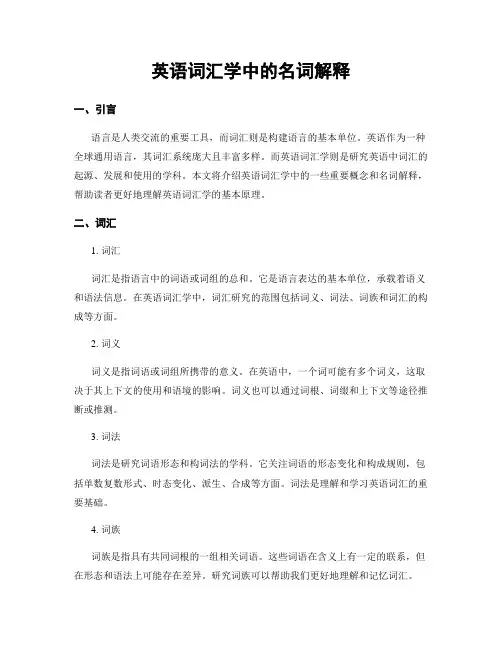
英语词汇学中的名词解释一、引言语言是人类交流的重要工具,而词汇则是构建语言的基本单位。
英语作为一种全球通用语言,其词汇系统庞大且丰富多样。
而英语词汇学则是研究英语中词汇的起源、发展和使用的学科。
本文将介绍英语词汇学中的一些重要概念和名词解释,帮助读者更好地理解英语词汇学的基本原理。
二、词汇1. 词汇词汇是指语言中的词语或词组的总和。
它是语言表达的基本单位,承载着语义和语法信息。
在英语词汇学中,词汇研究的范围包括词义、词法、词族和词汇的构成等方面。
2. 词义词义是指词语或词组所携带的意义。
在英语中,一个词可能有多个词义,这取决于其上下文的使用和语境的影响。
词义也可以通过词根、词缀和上下文等途径推断或推测。
3. 词法词法是研究词语形态和构词法的学科。
它关注词语的形态变化和构成规则,包括单数复数形式、时态变化、派生、合成等方面。
词法是理解和学习英语词汇的重要基础。
4. 词族词族是指具有共同词根的一组相关词语。
这些词语在含义上有一定的联系,但在形态和语法上可能存在差异。
研究词族可以帮助我们更好地理解和记忆词汇。
5. 词汇构成词汇构成是指由词根、词缀和其他语法成分组合而成的词语。
在英语中,许多词汇都是通过加上前缀、后缀或派生词缀来构建的。
研究词汇构成可以帮助我们学习和运用更多的词汇。
三、语义1. 语义语义是研究语言意义的学科。
它关注语言符号和所表示的意义之间的关系,包括词语、句子和篇章的意义。
在英语词汇学中,研究语义可以帮助我们理解和区分词语之间的差异。
2. 同义词同义词是指在特定语境下具有类似或相同意义的词语。
在英语中,同义词的选择可以丰富语言的表达,同时也对理解和翻译起到重要作用。
3. 反义词反义词是指在意义上相对对立或相互排斥的词语。
它们可以用来表达相反的概念或情感。
在英语中,反义词常常通过前缀、后缀或词根的变化来形成。
4. 上位词与下位词上位词是指泛指概念的词语,下位词则是指具体的概念。
例如,动物是"猫"的上位词,而"猫"是动物的下位词。
词汇学术语
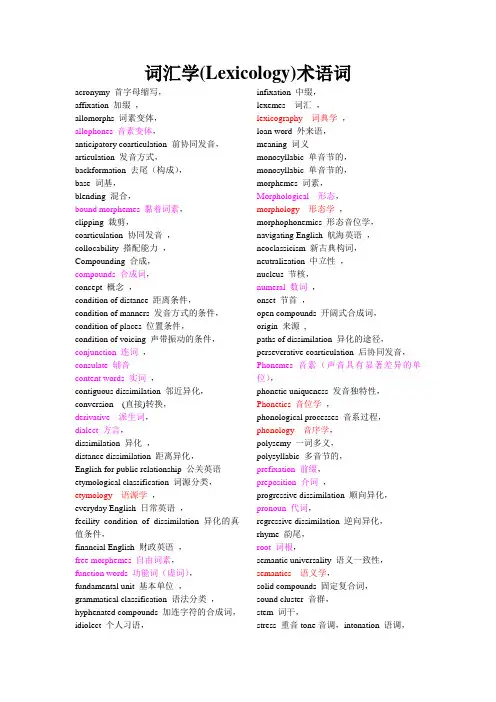
词汇学(Lexicology)术语词acronymy 首字母缩写,affixation 加缀,allomorphs 词素变体,allophones 音素变体,anticipatory coarticulation 前协同发音,articulation 发音方式,backformation 去尾(构成),base 词基,blending 混合,bound morphemes 黏着词素,clipping 裁剪,coarticulation 协同发音,collocability 搭配能力,Compounding 合成,compounds 合成词,concept 概念,condition of distance 距离条件,condition of manners 发音方式的条件,condition of places 位置条件,condition of voicing 声带振动的条件,conjunction 连词,consulate 辅音content words 实词,contiguous dissimilation 邻近异化,conversion (直接)转换,derivative 派生词,dialect 方言,dissimilation 异化,distance dissimilation 距离异化,English for public relationship 公关英语etymological classification 词源分类,etymology 语源学,everyday English 日常英语,fecility condition of dissimilation 异化的真值条件,financial English 财政英语,free morphemes 自由词素,function words 功能词(虚词),fundamental unit 基本单位,grammatical classification 语法分类,hyphenated compounds 加连字符的合成词,idiolect 个人习语,infixation 中缀,lexemes 词汇,lexicography 词典学,loan word 外来语,meaning 词义monosyllabic 单音节的,monosyllabic 单音节的,morphemes 词素,Morphological 形态,morphology 形态学,morphophonemics 形态音位学,navigating English 航海英语,neoclassicism 新古典构词,neutralization 中立性,nucleus 节核,numeral 数词,onset 节首,open compounds 开阔式合成词,origin 来源,paths of dissimilation 异化的途径,perseverative coarticulation 后协同发音,Phonemes 音素(声音具有显著差异的单位),phonetic uniqueness 发音独特性,Phonetics 音位学,phonological processes 音系过程,phonology 音序学,polysemy 一词多义,polysyllabic 多音节的,prefixation 前缀,preposition 介词,progressive dissimilation 顺向异化,pronoun 代词,regressive dissimilation 逆向异化,rhyme 韵尾,root 词根,semantic universality 语义一致性,semantics 语义学,solid compounds 固定复合词,sound cluster 音群,stem 词干,stress 重音tone音调,intonation 语调,stylistics 文体学,suffixation 后缀,suprasegmentals 超音段特征,syllables 音节,syntactic function 句法功能,transferring 转换,varieties 变体,vowel 元音,word-class 词性,。
英语词汇学引论 术语翻译
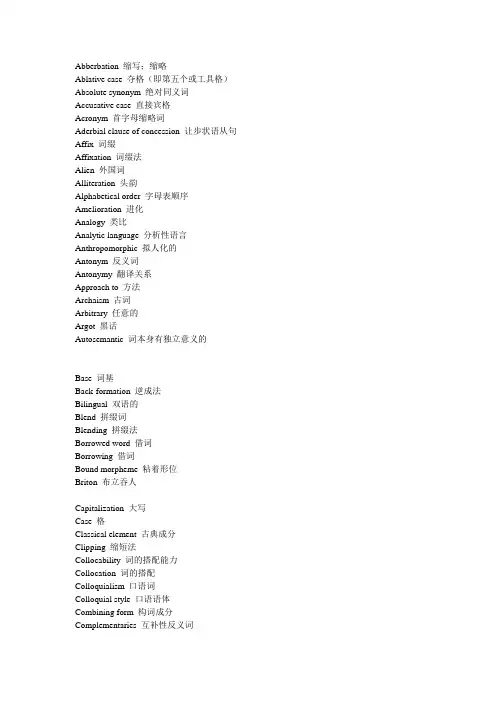
Abberbation 缩写;缩略Ablative case 夺格(即第五个或工具格)Absolute synonym 绝对同义词Accusative case 直接宾格Acronym 首字母缩略词Aderbial clause of concession 让步状语从句Affix 词缀Affixation 词缀法Alien 外国词Alliteration 头韵Alphabetical order 字母表顺序Amelioration 进化Analogy 类比Analytic language 分析性语言Anthropomorphic 拟人化的Antonym 反义词Antonymy 翻译关系Approach to 方法Archaism 古词Arbitrary 任意的Argot 黑话Autosemantic 词本身有独立意义的Base 词基Back-formation 逆成法Bilingual 双语的Blend 拼缀词Blending 拼缀法Borrowed word 借词Borrowing 借词Bound morpheme 粘着形位Briton 布立吞人Capitalization 大写Case 格Classical element 古典成分Clipping 缩短法Collocability 词的搭配能力Collocation 词的搭配Colloquialism 口语词Colloquial style 口语语体Combining form 构词成分Complementaries 互补性反义词Complex word 复合词Compound 合成词Compound word 合成词Compounding 合成法Concatenation 连锁型语义演变过程Conjugation 动词变位Connotative meaning 内含意义Context 语境Contraries 相对性反义词Conventional 约定俗成的Converging sound-development 语音发展的一致性Conversion 转类法Conversives 换位性反义词Cosmopolitan character 国际性Dative case 与格(第三格)De-adjectival 由形容词转变而来的Declension 名词、形容词等的变格Degradation of meaning 意义的降格Denizen 外来词Denominal nouns :abstract 纯名词表示抽象意义Denominal nouns :concrete 纯名词表示具体意义Denotative meaning 外延意义Derivative antonym 派生反义词Deterioration 退化Deverbal noun 由动词派生的名词Diachronic approach 历时分析法Diachronic dictionary 历史语言学词典Diachrony 历时分析Dialect 方言Double genitive case 双生格Doublets 两词一组的同义词Elevation of meaning 意义的升格Encyclopaedic dictionary 百科全书词典Entry 词条Etymology 词源学Euphemism 委婉语Euphony 语音的和谐悦耳Existing word 现行的词Exocentric word 离心结构合成词Extension of meaning 意义的扩大Figure of speech 修饰手段Figurative use 比喻用法Foreign element 外来语成分Formal word 书面词Form-word 虚词Free from 自由形式Free morpheme 自由形位Free phrase 自由词组French element 法语成分Full conversion 完全转类法Full word 实词Functional word 虚词Generalization 一般化Genitive case 生格(第二格)General dictionary 一般性词典Glossary 难词Headword 词目Homoform 同语法形式异义词Homograph 同形异音异义词Homonym 同音异义词;同形异义词;同音同形异义词Homonymy 同音、同形、同音同形异义词的研究Homophone 同音异形异义词Hybrid 混合词Hyponym 下意词Hyponymy 上下意关系Idiom 习语Idiomatic phrase 惯用语词组Imperative sentence 祈使句Indo-European family 印欧语系Inflected language 曲折性语言Informal word 口语词Jargon 行话Latin element 拉丁语成分Leveled inflections 曲折变化弱化Linguistic context 语言语境Literal use 字面用法Loan-word借词Locative case 位置格Locative prefix 表示地点的前缀Lost inflections 曲折变化消失Main stress 主重音Medium-sized dictionary 中型词典Metaphor隐喻Middle English 中古英语Miscellaneous prefix 混合型前缀Monosemy 一词单意Morpheme 形位Morphology 词法Motivation 理据Multilingual 用多种语言表达的;多语的Narrowing of meaning 意义的缩小Native element 本族语成分Native word 本族语词Negative prefix 表示否定的前缀Neo-classical 新古典主义的Neologism 新词New word 新词Nominative case 主格Nonce word 临时造的词Non-linguistic context 非语言语境Notional word 实词Number prefix 表示数目的前缀Obsolete word 费词Official language 官方语言Old English 古英语Onomatopoeia 象声词Open 分开写的Orthographic criterion 正字法标准Part of the speech 词类Partial conversion 部分转类法Pejorative prefix 表示贬义的前缀Pahatic communion 交际性谈话Phonetics 语音学Phonology 音位学Phraseological idiom 熟语Physiology 生理学Pocket dictionary 小型词典Polarity 对立性Polysemic character 一词多义性Polysemy 一词多义Popular 通俗的Possessive case 所有格Preciseness 精确性Prefix 前缀Prefixation 前缀法Private prefix 表示反义的前缀radiation 放射型的语义演变过程reduplicative compound 或者reduplicative(s )重叠合成词reference 语词所指涵义referent 语词所指事物relative synonym 相对同义词repetition 重复representative work 代表作reversative prefix表示反义的前缀rhyme 韵脚richness丰富性root 词根root antonym词根反义词Scandinavian element 斯堪的纳维亚语成分Secondary stress次重音Semantic borrowing(s)义借词Semantics语义学Semiotic triangle三角关系符号学理论Sense-shift语义转换Shade of meaning意义的(细微)差别Shortening缩短法(the)sign theory of Saussure索绪尔符号理论Signified(借助符号进行交际的)事物的概念或涵义Signifier代表事物的概念或涵义符号Simile明喻Slang俚语solid(合成词中两个词)连起来写的special dictionary专门性词典specialization 特殊化Spelling拼写Stem词干Stylistics文体学Suffix后缀Suffixation后缀法(the)superordinate (term)上义词Survival(s)(vestiges)保留下来的词Sychronic approach共时分析法Sychronic dictionary共时语言学词典Synchrony共时分析Synesthetic(产生)联觉的Synecdoche提喻法Synonym同义词Synonymy 同义关系Synsemantic 与其他词连用时才有意义的Teutonic language条顿(日耳曼)语言The Angles,Saxons and Jutes盎格鲁人撒克逊人,朱特人The Norman conquest 诺曼征服英国Translation-loans译借词Triplets三词一组的同义词Unabridged dictionary 大型(无任何删节的)词典Variety (语言的)变体Word-class 词类Word -formation word-building 构词法Word-forming ability 构词能力Word-stock词汇Working language 工作语言。
《英语词汇学》重要术语中英文对照
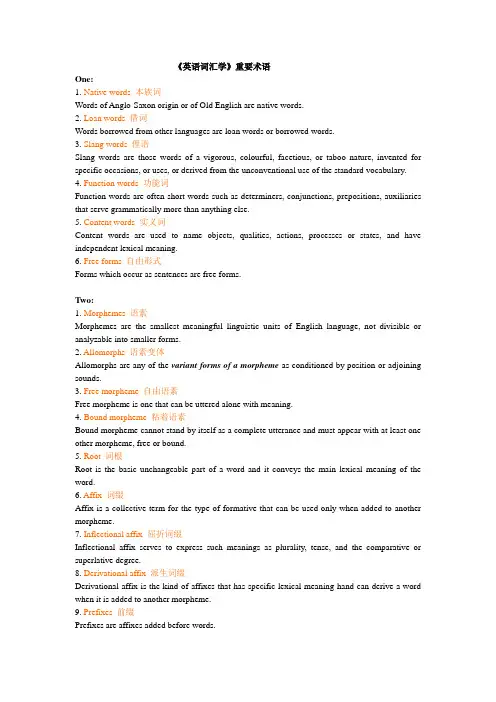
《英语词汇学》重要术语One:1. Native words 本族词Words of Anglo-Saxon origin or of Old English are native words.2. Loan words 借词Words borrowed from other languages are loan words or borrowed words.3. Slang words 俚语Slang words are those words of a vigorous, colourful, facetious, or taboo nature, invented for specific occasions, or uses, or derived from the unconventional use of the standard vocabulary. 4. Function words 功能词Function words are often short words such as determiners, conjunctions, prepositions, auxiliaries that serve grammatically more than anything else.5. Content words 实义词Content words are used to name objects, qualities, actions, processes or states, and have independent lexical meaning.6. Free forms 自由形式Forms which occur as sentences are free forms.Two:1. Morphemes 语素Morphemes are the smallest meaningful linguistic units of English language, not divisible or analyzable into smaller forms.2. Allomorphs 语素变体Allomorphs are any of the variant forms of a morpheme as conditioned by position or adjoining sounds.3. Free morpheme 自由语素Free morpheme is one that can be uttered alone with meaning.4. Bound morpheme 粘着语素Bound morpheme cannot stand by itself as a complete utterance and must appear with at least one other morpheme, free or bound.5. Root 词根Root is the basic unchangeable part of a word and it conveys the main lexical meaning of the word.6. Affix 词缀Affix is a collective term for the type of formative that can be used only when added to another morpheme.7. Inflectional affix 屈折词缀Inflectional affix serves to express such meanings as plurality, tense, and the comparative or superlative degree.8. Derivational affix 派生词缀Derivational affix is the kind of affixes that has specific lexical meaning hand can derive a word when it is added to another morpheme.9. Prefixes 前缀Prefixes are affixes added before words.10. Suffixes 后缀Suffixes are affixes added after words.Three1. Word-formation rules 构词规则Word-formation rules define the scope and methods whereby speakers of a language may create new words.2. Stem 词干Stem is the part of the word-form which remains when all inflectional affixes have been removed.3. Base 词基Base is any form to which affixes of any kind can be added.4. Compounding 合成法Compounding is a word-formation process consisting of joining two or more bases to form a new unit.5. Derivation 派生法Derivation or affixation is a word-formation process by which new words are created by adding a prefix, or suffix, or both, to the base.6. Conversion 转化法Conversion is a word-formation process whereby a word of a certain word-class is shifted into a word of another word-class without the addition of an affix.7. Prefixation 前缀法Prefixation is the addition of a prefix to the base.8. Suffixation 后缀法Suffixation refers to the addition of a suffix to the base.Four:1. Initialism 首字母连写词Initialism is a type of shortening, using the first letters of words to form a proper name, a technical term or a phrase and it is pronounced letter by letter.2. Acronyms首字母拼音词Acronyms are word formed from the initial letters of the name of an organization or a scientific term, and they are pronounced as words rather than as sequences of letters.3. Clipping 截短法The process of clipping involves the deletion of one or more syllables from a word (usually a noun), which is also available in its full form.4. Blending 拼缀法Blending is a process of word-formation in which a new word is formed by combining the meanings and sounds of two words, one of which is not in its full form or both of which are not in their full forms.5. Back-formation 逆成法Back-formation is a type of word-formation by which a shorter word is coined by the deletion of a supposed affix from a longer form already present in the language.6. Reduplication 重叠法Reduplication is a minor type of word-formation by which a compound word is created by therepetition of one word or of two almost identical words with a change in the vowels or of two almost identical words with a change in the initial consonants.7. Neoclassical formation 新古典词构成法Neoclassical formation is the process by which new words are formed from elements derived from Latin and Greek.Five:1. Conventionality 约定俗成It is the characteristics of relation between the sound-symbol and its sense: there is no way to explain why this or that sound-symbol has this or that meaning beyond the fact that the people of a given community have agreed to use one to designate the other.2. Motivation 理据Motivation refers to the direct connection between word-symbol and its sense.3. Echoic/onomatopoeic words 拟声词Echoic words or onomatopoeic words are words motivated phonetically whose pronunciation suggests the meaning.4. Morphological motivation 语素结构理据A word is morphologically motivated if a direct connection can be observed between the morphemic structure of the word and its meaning.5. Semantic motivation 语义理据Semantic motivation refers to motivation based on semantic factors and it is usually provided by the figurative usage of words.6. Grammatical meaning 语法意义Grammatical meaning consists of word-class and inflectional paradigm.7. Inflectional paradigm 词形变化The set of grammatical forms of a word is called its inflectional paradigm. Nouns are declined, verbs are conjugated and gradable adjectives have degrees of comparison.8. Denotative meaning 外延意义The denotative meaning of a word is its definition given in a dictionary.9. Connotative meaning 内涵意义Connotative meaning refers to the emotional association which a word or a phrase suggests in one’s mind.10. Social or stylistic meaning 社会意义Social meaning is that which a piece of language conveys about the social circumstances of its use.11. Affective meaning 情感意义Affective meaning is concerned with the expression of feelings and attitudes of the speaker or writer.12. Componential analysis 语义成分分析The conceptual meaning or denotative meaning can be broken down into its minimal distinctive components which are known as semantic features. Such an analysis is called componential analysis.Six:1. Polysemy 一词多义Polysemy happens when more than one meaning is attached to a word.2. Radiation 词义辐射Semantically, radiation is the process in which the primary or central meaning stands at the center while secondary meanings radiate from it in every direction like rays.3. Concatenation 语义的连锁、联结Concatenation is a semantic process in which the meaning of a word moves gradually away from its first sense by successive shifts, like the links of a chain, until there is no connection between the sense that is finally developed and the primary meaning.4. Homonymy 同音异义、同形异义Homonymy is the relation between pairs or groups of word which, though different in meaning, are pronounced alike, or spelled alike or both.5. Perfect homonyms 完全同音同形异义词Words identical in sound and spelling but different in meaning are called perfect homonyms.6. Homophones 同音异义词Words identical in sound but different in spelling and meaning are called homophones.7. Homographs 同形异义词Words identical in spelling but different in sound and meaning are called homographs.8. Phonetic convergence 音变的汇合Phonetic convergence is the kind of phenomenon where two or more words which once were different in sound forms take on the same pronunciation.9. Semantic Divergence 词义分化When two or more meanings of the same word drift apart to such an extent that there will be no obvious connection between them, the word has undergone the process of semantic divergence.Seven:1. Synonyms 同义词A synonym may be defined as a word having the same meaning as another word: as one of two or more words of the same language and grammatical category having the same essential or generic meaning and differing only in connotation, application, or idiomatic use.2. Complete synonyms 完全同义词Two words are totally synonymous only if they are fully identical in meaning and interchangeable in any context without the slightest alteration in connotative, affective and stylistic meanings.3. Relative synonyms 相对同义词Relative synonyms are words that are not fully identical but may differ in shades of meaning, in emotional colouring, in level of formality, in collocation, and in distribution.4. Antonymy 反义关系In its general sense, antonymy refers to all types of semantic oppositeness.5. Contraries/gradable antonyms 相对性反义词Contraries or contrary terms display such a type of semantic contrast that they can be handled in terms of gradability, that is, in terms of degrees of the quality involved.6. Complementaries/contradictory terms 互补性反义词Complementaries or contradictories represent a type of binary semantic opposition so that theassertion of one of the items implies the denial of the other.7. Conversives/converses/relational opposites 换位性反义词Conversives represent such a type of binary semantic opposition that there is an interdependence of meaning, or say, one member of the pair presupposes the other.8. Hyponymy 上下义关系Hyponymy is the relationship which obtains between specific and general lexical items, such that the former is included in the latter.9. Superordinates 上义词The general term in a hyponymy pair is called a superordinate linguistically.10. Hyponyms 下义词The specific term in a hyponymy pair is called the hyponym or subordinate.11. Semantic field 语义场Semantic field theory is concerned with the vocabulary of a language as a system of interrelated lexical networks. The words of a semantic field are joined together by a common concept, and they are likely to have a number of collocations in common.Eight:1. Context 语境Context in its narrowest sense consists of the lexical items that come immediately before and after any word in an act of communication. But, in broader sense, it may cover the whole passage and sometimes the whole book in which a word occurs, and in some cases even the entire social or cultural setting.2. Linguistic context 语言语境Linguistic context is lexical, grammatical and verbal context in its broad sense.3. Extra-linguistic context 语言之外的环境Extra-linguistic context refers not only to the actual speech situation in which a word is used but also to the entire cultural background against which a word, or an utterance or a speech event is set.4. Lexical context 词汇语境Lexical context refers to the lexical items combined with a given polysemous word.5. Grammatical context 语法语境In grammatical context, the syntactic structure of the context determines various individual meanings of a polysemous word.6. Verbal context 言语语境The verbal context, in its broadest sense, may cover an entire passage, or even an entire book, and in some cases even the entire social or cultural setting.7. Ambiguity 歧义Ambiguity refers to a word, phrase, sentence or group of sentences with more than one possible interpretation or meaning.8. Lexical ambiguity 词汇歧义Lexical ambiguity is caused by polysemy.9. Structural ambiguity 结构歧义Structural ambiguity arises from the grammatical analysis of a sentence or a phrase.Nine:1. Change of word meaning 语义变化When a word loses its old meaning and comes to refer to something altogether different, the result is a change of word meaning. Broadly speaking, change of meaning refers to the alteration of the meaning of existing words as well as the addition of new meaning to establish words.2. Restriction of meaning 语义专门化Restriction of meaning or specialization of meaning means that a word of wide meaning acquires a narrower, specialized sense which is applicable to only one of the objects it had previously denoted.3. Extension of meaning 词义扩展化Extension of meaning or generalization means the widening of a word’s sense until it covers much more than what it originally conveyed.4. Degeneration of meaning 词义降格There are two main forms of degeneration or pejoration. One refers to the process where words once respectable or neutral may shift to a less respectable, or even derogatory meaning. The other refers to the weakening of meaning resulting from habitual use of particular words on unsuitable occasions.5. Elevation of meaning 词义升格It refers to the process that the meaning of a word goes uphill.6. Metaphor 暗喻Metaphor is a figure of speech containing an implied comparison based on association of similarity, in which a word or a phrase ordinarily and primarily used for one thing is applied to another.7. Metonymy 转喻It is a figure of speech by which an object or idea is described by the name of something closely related to it.Ten:1. Idiom 习语An English idiom is a group of words with a special meaning different from the meanings of its constituent words. It is a combination of two or more words which are usually structurally fixed and semantically opaque, and function as a single unit of meaning.2. Phrase idioms 惯用短语All phrase idioms have a noun, verb, adjective, preposition or an adverb as the central word and correspond to the familiar parts of speech, and are capable of a given syntactic function.3. Clause idioms 从句成语Clause idioms or subject-less clause patterns contain objects and / or complements.4. Sentence idioms 句子成语The two major types of sentence idioms are proverbs or sayings and typical conversational expressions.5. Proverbs 谚语Proverbs are sentences accepted by the people and handed down to the present day because they express some obvious truth or familiar experience in a concise and witty style.。
英语词汇学 术语解释
Lexicology is a branch of linguistics,inquiring into the origins and meanings of words.Morphology: the study of morpheme and their different forms。
Semantics:the study of word meaning。
Etymology:the study of the origin of words, and of their history and changes in their meaning。
Stylistics : the study of the variation in language which is dependent on the situation in which the language is used and also on the effect the writer or speaker wishes to create on the reader or hearerLexicography:the compiling of dictionaries。
Synchronic study:the study of a word or words at one particular point in time。
Diachronic study:an approach to lexicology which studies how a word (or words) changes over a period of time。
word: a word is a minimal free form of a language that has a given sound and meaning and syntactic function。
英语词汇学名词解释
英语词汇学名词解释英语词汇学在英语学习和教学中,词汇是非常重要的一部分。
英语词汇学研究的是英语词汇的形成、分类、演变和使用等方面的知识。
下面是一些与英语词汇学相关的名词及其解释:1. 词汇(Vocabulary)•词汇是指某一语言系统中的全部词语的总称。
•例子:英语中的词汇包括单词(words),短语(phrases),习语(idioms)等。
2. 词义(Semantics)•词义是指词语所表示的意义或概念。
•例子:单词”apple”表示一种水果。
3. 词根(Root)•词根是构成单词的核心部分,具有词义的基本含义。
•例子:词根“tele-”表示“远程”,如单词”television”表示“远距离看”。
4. 词形(Morphology)•词形是指词语形态上的变化,包括词根的变化、词缀的添加和词语形式的变化等。
•例子:单词”run”经过词形变化可以有”running”(进行时态)和”ran”(过去时态)等形式。
5. 词汇量(Vocabulary Size)•词汇量是指一个人掌握或理解的词汇数量。
•例子:一般来说,英语水平高的人词汇量会相对较大。
6. 同义词(Synonym)•同义词是指语义相近的两个或多个词语。
•例子:“happy”和”glad”都是表示“高兴”的同义词。
7. 反义词(Antonym)•反义词是指意义相对立的两个词语。
•例子:“big”和”small”是表示“大”和“小”的反义词。
8. 多词性(Polysemy)•多词性是指一个词语具有多个不同但相关的词义。
•例子:单词”bank”可以表示“银行”或“河岸”。
9. 词汇补偿(Vocabulary Compensation)•词汇补偿是指在理解语言时,通过上下文和其他线索来推测未知词汇的意义。
•例子:如果不认识单词”obscure”,可以通过上下文来猜测它的意义是“不清楚的”。
这些名词和概念在英语词汇学中起着重要的作用,了解它们可以帮助我们更好地学习和使用英语词汇。
词汇学名词解释
词汇学名词解释词汇学是研究语言中的词汇(单词)和词汇使用的学科。
在词汇学中,有很多专业术语,下面将对其中的几个常用术语进行解释。
1. 词汇(Vocabulary):语言中使用的词语的集合。
2. 词(Word):语言中的最小语言单位,具有单独的意义和语音形式。
3. 词根(Root):词中含有全词意义的核心成分,通常是一个字母组合。
例如,“tele-”是“telephone”这个词的词根。
4. 词缀(Affix):可以加在词根前、中或后的一个或多个字母,用于改变词的含义。
例如,“-er”是“teacher”这个词的词缀。
5. 合成词(Compound Word):将两个或更多的词或词根组合成一个新的词。
例如,“lighthouse”(灯塔)由“light”和“house”两个词合成而成。
6. 前缀(Prefix):位于词根前面的一个或多个字母,可以改变词的含义。
例如,“re-”是“return”这个词的前缀。
7. 后缀(Suffix):位于词根后面的一个或多个字母,可以改变词的词性或含义。
例如,“-able”是“comfortable”这个词的后缀。
8. 短语(Phrase):由两个或多个单词组成的词组,没有主语和谓语。
例如,“in the morning”(在早晨)是一个短语。
9. 句子(Sentence):有明确的主语和谓语,可以表达一个完整的意思。
以上是词汇学中常见的术语解释,它们有助于我们更好地理解语言中的单词和词组。
除此之外,词汇学还研究了词的来源、演变、分类和使用等方面,是一门十分重要的学科。
英语词汇学+术语翻译
Terminology Translations英语词汇学术语翻译安徽/合肥/肥西路3号/安徽大学外语学院/朱跃 Aacronym 首字母拼音词acronymy 首字母拼音法addition 增词adjective compound 复合形容词affective meaning 感情意义affix 词缀affixation 词缀法Albanian 阿尔巴尼亚语(族)aliens 非同化词alliteration 头韵(法)allomorph 词素(形位)变体ambiguity 歧义amelioration of meamng 词义的升华analogy 类推analytic language 分析性语言antithsis 对偶antonym 反义词antonymy 反义关系appreciative term 褒义词archaic word 古词archaism 古词语argot 隐语(黑话)Armenian 亚美尼亚语(族)Associated transfer 联想转移association 联想associative meanings 关联意义Bback-formation 逆生法back clipping 词尾截短Balto-Slavic 波罗斯拉夫语(族)bilinguall 双语的basic word stock 基本词汇blend 拼缀词blending 拼缀法borrowed word 借词bound form粘着形式bound morpheme 粘着语素(形位)bound root 粘着词根Ccasual style 随便文体catchPhrase 时髦语Celtic 凯尔特语(族)central meaning 中心意义Clipping 截短法collocability 搭配能力collocation 搭配collocative meaning 搭配意义colloquialism 口语词(口语体)complete synonym 完全同义词complex word 复杂词composition 复合法compound 复合词compounding 复合法concatenation 连锁型concept 概念conceptual meaning 概念意义connotation 内涵connotative meanins 内涵意义constituent 要素.成分consultative style 交谈体(咨询体)content word 实义词context 语境contradictory term矛盾反义词contrary terms 对立反义词conversion 转类法couplet 成对词Dde-adjective 由形容词转化的de-adjectival 由形容词转化的 degradation of meaning 词义的降格deletion 减词denizen 同化同denominal 由名词转化的denotation外延denotative meaning 外延意义derivation 派生法derivational affiX 派生词缀derivative 派生词derived meaning 派生意义derogatory sense 贬义desk dictionary 案头词典deverbal noun 由动词转化的名词deverbal suffix 加于动词的后缀diachronic approach 历时角度dialectal word 方言词discipline 学科dismembering 肢解distribution分布doublet 成对词duplication of synonyms 同义词并举Fformal 正式的free form 自由形式free morpheme 自由语素(形位)free root 自由词根frontclipping 首部截短front and back clipping 首尾部截短frozen style 拘谨体full conversion 完全转换functional shift 功能转换G generalisation of meaning 词义的扩大Germanic 日耳曼语族grammatical meaning 语法意义gradable adjective 等级形容词grammatical context 语法语境grammatical feature 语法特征graphology 书写法;图解法HHellenic 希腊语族heterogeneous 多质的highly-inflected 高度屈折化的homograph 同形异义词homonym 同形同音异义词homonymy 同形同音异义关系homphone 同音异义词hyperonym 上义(位)词hyponym 下义(位)词hyponymy 上下义(位)关系Iidiom 习语idiomatic expression 习惯表达idiomaticity 习语程度Indo-European Language Family 印欧语系Indo-Iranian 印伊语族inflection 屈折变化inflectional affix 屈折词缀intensity of meaning 意义强度initialism 首字母缩略词intermediate member 中间成分intimate style 亲昵语体Italic 意大利语族Jj uxtaposition of antonyms 反义词并置 L1exical context 词汇语境lexical item 词汇项目lexicography 词典学lexicology 词汇学lexis 词汇linguistic context 语言语境literary 书面的loan word 借词lexical meaning 词汇意义Mmarked term有标记项metaphor 暗喻metonymy 换喻monolingual 单语的morph 形素monomorphemic 单语素的monosemic 单义的morpheme 词素(形位)morphological structure 形态结构morphology 形态学motivation 理据motivated 有理据的Nnative word 本族语词neoclassical 新古典词的neologism 新词语notional word 实义词Oobjective meaning 客观意义obsolete 废弃词onomatopoeic motivation 拟声理据Orthographic feature 拼写特征PPartial conversion 部分转化Pejoration 贬义化Perpect homonym 同形同音异义词phonetic feature 语音特征phono1ogical 音位学的phonology 音位学phrasal verb 短语动词phrase clipping 短语截短pocket dictionary 袖珍词典polysemic 多义的polysemous 多义的polysemant 多义词polysemantic 多义的polysemy 多义关系pormanteau word 拼级词positionshifting 移位prefix 前缀prefixation 前缀法primary meaning 原始意义productivity 多产性pun 双关语Rradiation 辐射range of meaning 词义范围reduplication 重叠referent 所指物reference 所指关系referential meaning 所指意义regional variety 地域变体register 语域reiteration(意义)重复。
